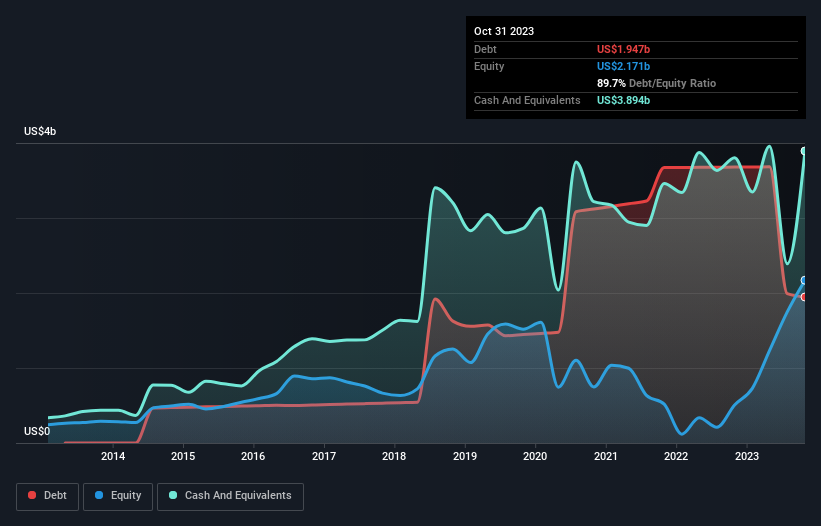
David Iben put it well when he said, 'Volatility is not a risk we care about. What we care about is avoiding the permanent loss of capital.' It's only natural to consider a company's balance sheet when you examine how risky it is, since debt is often involved when a business collapses. We note that Palo Alto Networks, Inc. (NASDAQ:PANW) does have debt on its balance sheet. But the more important question is: how much risk is that debt creating?
When Is Debt Dangerous?
Generally speaking, debt only becomes a real problem when a company can't easily pay it off, either by raising capital or with its own cash flow. If things get really bad, the lenders can take control of the business. However, a more common (but still painful) scenario is that it has to raise new equity capital at a low price, thus permanently diluting shareholders. Of course, plenty of companies use debt to fund growth, without any negative consequences. The first step when considering a company's debt levels is to consider its cash and debt together.
See our latest analysis for Palo Alto Networks
What Is Palo Alto Networks's Debt?
You can click the graphic below for the historical numbers, but it shows that Palo Alto Networks had US$1.95b of debt in October 2023, down from US$3.68b, one year before. But it also has US$3.89b in cash to offset that, meaning it has US$1.95b net cash.

How Healthy Is Palo Alto Networks' Balance Sheet?
The latest balance sheet data shows that Palo Alto Networks had liabilities of US$7.51b due within a year, and liabilities of US$5.12b falling due after that. On the other hand, it had cash of US$3.89b and US$1.86b worth of receivables due within a year. So its liabilities outweigh the sum of its cash and (near-term) receivables by US$6.89b.
Of course, Palo Alto Networks has a titanic market capitalization of US$94.0b, so these liabilities are probably manageable. Having said that, it's clear that we should continue to monitor its balance sheet, lest it change for the worse. While it does have liabilities worth noting, Palo Alto Networks also has more cash than debt, so we're pretty confident it can manage its debt safely.
Although Palo Alto Networks made a loss at the EBIT level, last year, it was also good to see that it generated US$587m in EBIT over the last twelve months. When analysing debt levels, the balance sheet is the obvious place to start. But ultimately the future profitability of the business will decide if Palo Alto Networks can strengthen its balance sheet over time. So if you're focused on the future you can check out this free report showing analyst profit forecasts.
Finally, a business needs free cash flow to pay off debt; accounting profits just don't cut it. Palo Alto Networks may have net cash on the balance sheet, but it is still interesting to look at how well the business converts its earnings before interest and tax (EBIT) to free cash flow, because that will influence both its need for, and its capacity to manage debt. Over the last year, Palo Alto Networks actually produced more free cash flow than EBIT. There's nothing better than incoming cash when it comes to staying in your lenders' good graces.
Summing Up
We could understand if investors are concerned about Palo Alto Networks's liabilities, but we can be reassured by the fact it has has net cash of US$1.95b. And it impressed us with free cash flow of US$2.9b, being 498% of its EBIT. So is Palo Alto Networks's debt a risk? It doesn't seem so to us. The balance sheet is clearly the area to focus on when you are analysing debt. However, not all investment risk resides within the balance sheet - far from it. Be aware that Palo Alto Networks is showing 1 warning sign in our investment analysis , you should know about...
If, after all that, you're more interested in a fast growing company with a rock-solid balance sheet, then check out our list of net cash growth stocks without delay.
New: Manage All Your Stock Portfolios in One Place
We've created the ultimate portfolio companion for stock investors, and it's free.
• Connect an unlimited number of Portfolios and see your total in one currency
• Be alerted to new Warning Signs or Risks via email or mobile
• Track the Fair Value of your stocks
Have feedback on this article? Concerned about the content? Get in touch with us directly. Alternatively, email editorial-team (at) simplywallst.com.
This article by Simply Wall St is general in nature. We provide commentary based on historical data and analyst forecasts only using an unbiased methodology and our articles are not intended to be financial advice. It does not constitute a recommendation to buy or sell any stock, and does not take account of your objectives, or your financial situation. We aim to bring you long-term focused analysis driven by fundamental data. Note that our analysis may not factor in the latest price-sensitive company announcements or qualitative material. Simply Wall St has no position in any stocks mentioned.
About NasdaqGS:PANW
Reasonable growth potential with adequate balance sheet.
Similar Companies
Market Insights
Community Narratives



